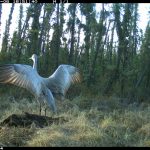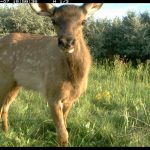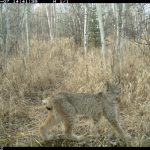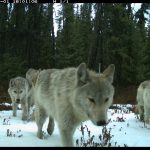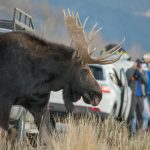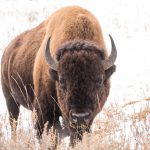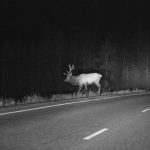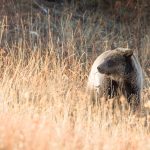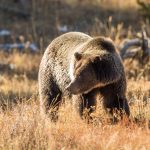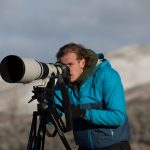Researchers Revealed explores new technologies that researchers are using to study the natural world. Following scientists from the Biodiversity Research Centre at the University of British Columbia, we travel from oceans to deserts and far-off jungles, uncovering the answers to some of our most pressing questions about life on Earth.
In Eyes in the Wild, producer Philippe Roberge and wildlife ecologist Cole Burton lift the lid on the secrets of camera traps and animal selfies in Yellowstone National Park.
A Conservation Biologist’s Perspective
My name is Cole Burton. I’m originally from Guelph, Ontario, and I’m an Assistant Professor in the Faculty of Forestry and a Canada Research Chair in terrestrial mammal conservation. I lead the Wildlife Coexistence Lab (WildCo for short), where we study interactions between people and wildlife. We focus mainly on large-bodied terrestrial mammals—species that that tend to get a lot of public attention, sometimes called “charismatic megafauna”, like caribou, grizzly bears, wolves and lions.
Our lab is interested in understanding how species react to their changing environments, particularly the mounting pressures we as a society are imposing on them by altering the landscapes they live in. We do this using a variety of different methods, but a key tool that we use is what we call camera trapping (also called remote camera surveys), which is a non-invasive technique that allows us to put cameras out in the landscape and let the animals take the pictures. Essentially a kind of true animal selfie. Warm-bodied animals take pictures of themselves by tripping a sensor as they move past these remote cameras. We deploy these across a variety of habitat types and land uses, and they provide us with a wealth of information on many rare and elusive species that are otherwise difficult to detect.
I first used camera traps during my PhD work in Ghana, West Africa. We were using old analog film cameras, which were quite difficult to work with. We could only get 24 or 36 pictures at a time (until the roll was filled up) and sometimes we had very poor-quality photos—particularly as we had to transport and develop the film in remote, humid, tropical conditions. But these days those limitations have been removed as digital camera technology has exploded. With the costs coming down and quality increasing, we can now gather huge quantities of data—really clear, crisp images—on these species in a cost-effective manner.
The great thing about camera traps is that they’re out there doing work for us all the time. If we had to send our field staff out to monitor animals around the clock, the costs would be completely prohibitive, and animals might avoid the observers. Whereas we can set a camera up and leave it out for months, or in some cases a year or longer, and it continues to record information. It’s triggered by both the motion of animals moving past it as well as a differential in heat, so it captures warm-bodied animals that have a higher heat than the ambient environment. It’s a very effective method for gathering a lot of information on wildlife and their environments.
We call our lab the Wildlife Coexistence lab because we’re focused on doing science that can support coexistence between human society and these species that require large areas of habitat and low disturbance. As we consider how to coexist with wildlife, we realize that we need good information on how wildlife are responding to their changing environments. And that’s why this information from our camera surveys is important to help us navigate the trade-offs between conservation and development.
One of the things we’re trying to do with our with our remote camera research is develop a network of collaborators and a community of practice. We know that many researchers, government biologists, and industry biologists are using camera traps, but right now they’re mostly using them in isolation. We believe that if we can bring these people together and share information across projects and regions, we can start to get the kind of large-scale information we need to inform our management of large landscapes. This is critical to conducting what we call “adaptive management”, where we use the way society is changing landscapes as experimental “treatments” and design our coordinated surveys to get stronger evidence to inform management actions. Camera traps are one important tool that can help us ask questions at the large scales that are needed to inform landscape management and human-wildlife coexistence.
You can learn more about the Wildlife Coexistence Lab and its work on Cole Burton’s website, and by catching up with the latest issue of Branchlines:
https://forestry.ubc.ca/publications/branchlines/?login
Behind the Scenes
- A wolf, captured with one of Cole’s remote cameras P.C: Cole Burton
- A sandhill crane, captured with one of Cole’s remote cameras P.C: Cole Burton
- One of Cole’s remote cameras placed out in the field
- A deer, captured with one of Cole’s remote cameras P.C: Cole Burton
- A lynx, captured with one of Cole’s remote cameras P.C: Cole Burton
- A wolf, captured with one of Cole’s remote cameras P.C: Cole Burton
- A large bull moose crosses the road as onlookers snap photos – a true human-wildlife co-existence moment P.C: Philippe Roberge
- A large bison approaches the road P.C: Philippe Roberge
- A male elk walks around in a residential area P.C: Philippe Roberge
- Behind the scenes with the very professional film crew P.C: Philippe Roberge
- A bull elk crosses the road at night P.C: Philippe Roberge
- An example of charismatic fauna P.C: Philippe Roberge
- A grizzly bear cub, standing within 100 meters of humans P.C: Philippe Roberge
- A mother grizzly, also standing within 100 meters of humans P.C: Philippe Roberge
- A female elk in a residential area P.C: Philippe Roberge
- Chris De Groot (L) and Tavis Pedersen (R), assistant camera operators
- Assistant camera operator Chris De Groot looks through our filming gear, generously sponsored by Canon Canada
- Producer Philippe Roberge manages a smile despite getting up at 4:00am to shoot in -25c temperatures


